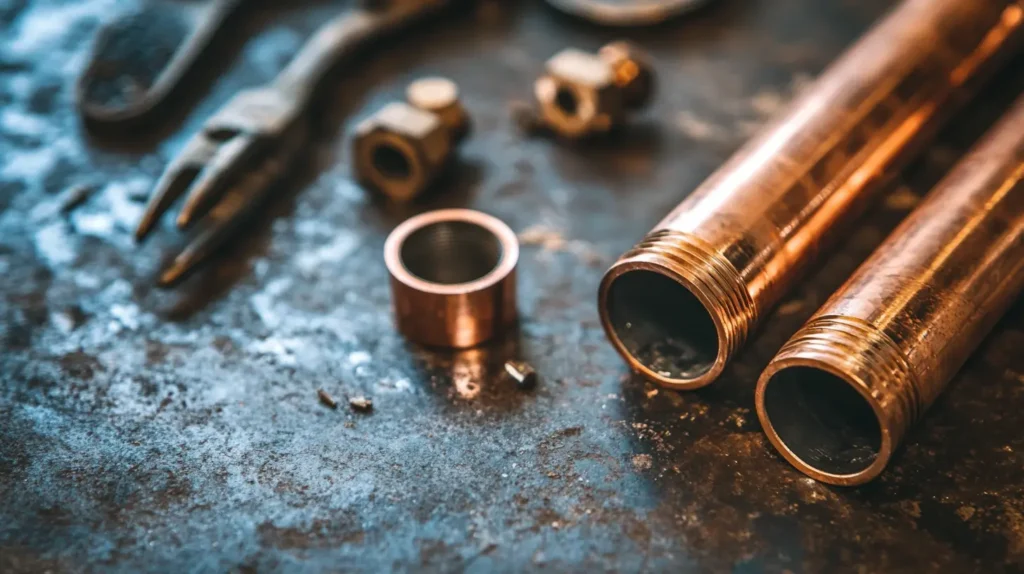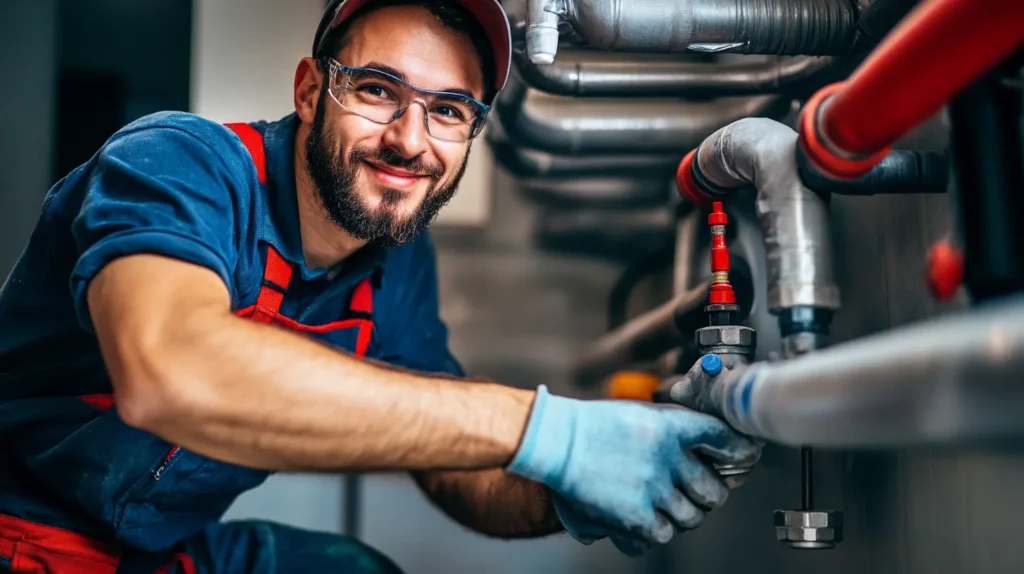When it comes to building or renovating a home in Northeast Florida, choosing the right plumbing materials is crucial. The region’s unique climate, with its high humidity, frequent rainfall, and occasional freezing temperatures, demands plumbing solutions that can withstand these conditions while ensuring durability and efficiency. This guide will help you navigate the selection process by exploring the best plumbing materials for your home, considering factors such as cost, longevity, and suitability for local weather.
Understanding the Challenges: Northeast Florida’s Plumbing Needs
Before diving into the specific materials, it’s essential to understand why selecting the right plumbing materials is so critical in Northeast Florida. The area’s subtropical climate poses several challenges:
- Humidity and Corrosion: High humidity levels can accelerate corrosion in certain types of metal pipes, leading to leaks and system failures.
- Water Quality: The water in this region is often hard, containing higher levels of minerals like calcium and magnesium. This can cause scaling inside pipes, reducing water flow and efficiency.
- Temperature Fluctuations: While Florida is known for its warm weather, winter temperatures can occasionally drop low enough to cause uninsulated pipes to freeze and burst.
Given these conditions, the plumbing materials you choose must be resilient, durable, and well-suited to the environment.
Key Considerations for Choosing Plumbing Materials
When selecting plumbing materials for your Northeast Florida home, consider the following factors:
- Durability: The materials must be able to withstand the region’s climate without deteriorating quickly.
- Cost: Balance upfront costs with long-term maintenance expenses. Sometimes, paying more initially for higher-quality materials can save money in the long run.
- Ease of Installation: Some materials are easier and faster to install than others, affecting labor costs and project timelines.
- Water Quality Compatibility: Choose materials that are resistant to the effects of hard water to prevent scaling and corrosion.
- Environmental Impact: Consider materials that are eco-friendly and have a minimal environmental footprint.
The Best Plumbing Materials for Homes in Northeast Florida
Now that we’ve outlined the challenges and considerations, let’s dive into the best plumbing materials suited for homes in Northeast Florida.
Copper Pipes: A Timeless Choice for Reliable Plumbing in Northeast Florida

Copper pipes have long been a cornerstone of residential plumbing, revered for their unmatched durability, reliability, and overall performance. As one of the oldest and most trusted materials in plumbing, copper has stood the test of time, proving its worth across generations of homeowners. Its exceptional qualities make it a prime choice, particularly in the challenging climate of Northeast Florida. This section will delve into the reasons why copper pipes remain a superior option, focusing on their corrosion resistance, longevity, compatibility with hard water, and some of the considerations that come with their use.
Corrosion Resistance: Standing Strong Against Humidity
One of the most significant advantages of copper pipes, especially in a humid region like Northeast Florida, is their remarkable resistance to corrosion. Humidity can wreak havoc on many metals, causing them to rust and deteriorate over time. However, copper is inherently resistant to the corrosive effects of moisture. This resistance is due to the formation of a protective oxide layer on the surface of the copper, which acts as a barrier against further corrosion. This feature is particularly beneficial in areas with high humidity levels, like the coastal regions of Florida, where metal pipes are often at risk of corrosion.
In contrast to other materials, such as galvanized steel, which can succumb to rust and weaken over time, copper maintains its integrity even in the most challenging environments. This corrosion resistance ensures that copper pipes can continue to deliver clean, uncontaminated water for decades, making them a reliable choice for homeowners who want to avoid the frequent replacements and repairs that other materials might require.
Long Lifespan: An Investment in Durability
Copper pipes are not only durable but also have an impressively long lifespan. When properly installed and maintained, copper pipes can last 50 years or more, outlasting many other plumbing materials. This longevity translates into significant cost savings over time, as the need for repairs and replacements is drastically reduced. In fact, copper’s durability is one of the primary reasons why it has been a preferred plumbing material for so long.
Moreover, the long lifespan of copper pipes makes them an excellent investment for homeowners who plan to stay in their homes for many years. While the initial cost of copper is higher than that of other materials, the long-term savings on repairs and replacements often justify the upfront expense. Homeowners in Northeast Florida, where the climate can be tough on plumbing, will especially benefit from the reliability that copper pipes provide.
Compatibility with Hard Water: Reducing Scale Buildup
Another critical advantage of copper pipes is their compatibility with hard water, which is common in many parts of Northeast Florida. Hard water contains high levels of dissolved minerals, such as calcium and magnesium, which can lead to scaling inside pipes. This scaling can reduce water flow, decrease efficiency, and eventually cause blockages or damage to the plumbing system.
Unlike some other metals, copper is less prone to scale buildup, making it an ideal choice for homes with hard water. The smooth interior surface of copper pipes resists the accumulation of mineral deposits, ensuring that water flows freely and that the pipes remain clear and functional for years. This resistance to scaling also means that homeowners will experience fewer issues related to water pressure and flow, reducing the need for maintenance and extending the life of the plumbing system.
Installation Considerations: Weighing the Costs
While copper pipes offer numerous advantages, there are some considerations to keep in mind, particularly regarding installation. Copper is a more expensive material compared to alternatives like PEX or PVC, both in terms of the material itself and the labor required for installation. Copper pipes need to be soldered together, a process that requires skilled labor and can increase the overall cost of the project.
However, many homeowners find that the long-term benefits of copper—its durability, longevity, and reliability—outweigh the higher initial costs. For those who prioritize a plumbing system that will stand the test of time, copper is often the preferred choice, despite the upfront expense.
In conclusion, copper pipes remain a top-tier option for plumbing in Northeast Florida. Their resistance to corrosion, long lifespan, and compatibility with hard water make them an excellent choice for homeowners who want a durable and reliable plumbing system. While the initial investment may be higher, the long-term benefits of choosing copper often make it a worthwhile choice for those looking to ensure the longevity and efficiency of their home’s plumbing.
PEX (Cross-linked Polyethylene) Pipes: The Flexible Solution for Modern Plumbing in Northeast Florida

In the world of modern plumbing, few materials have made as significant an impact as PEX (cross-linked polyethylene). Over the past few decades, PEX has emerged as a leading choice for both residential and commercial plumbing systems, thanks to its remarkable flexibility, durability, and ease of installation. Particularly in regions like Northeast Florida, where the climate and environmental conditions can pose unique challenges, PEX has proven to be a versatile and reliable option. This section explores the many benefits of PEX pipes, with a focus on their freeze resistance, flexibility, cost-effectiveness, and the considerations homeowners should keep in mind when choosing this material.
Flexibility: Navigating the Complexities of Installation
One of the standout features of PEX pipes is their unparalleled flexibility. Unlike rigid materials such as copper or PVC, PEX pipes can easily bend and curve, allowing them to be routed through walls, around corners, and in tight spaces without the need for additional fittings or joints. This flexibility not only simplifies the installation process but also reduces the potential for leaks. Fewer joints mean fewer opportunities for weak spots in the system where leaks might occur, making PEX a particularly robust choice for complex plumbing layouts.
In Northeast Florida, where homes often feature a mix of new construction and older architecture, the ability to retrofit PEX into existing systems without extensive demolition is a significant advantage. Whether you’re renovating an older home or installing a new plumbing system, PEX’s flexibility allows for a smoother, less invasive installation process, saving both time and money.
Freeze Resistance: Built to Handle Temperature Extremes
While Northeast Florida is known for its warm climate, the region is not immune to occasional cold snaps, which can pose a risk to plumbing systems. One of the key advantages of PEX pipes is their freeze resistance. Unlike metal pipes, which can crack or burst when water inside them freezes, PEX pipes have the ability to expand slightly under pressure. This expansion reduces the risk of the pipe bursting during freezing temperatures, a feature that provides peace of mind for homeowners during unexpected cold weather events.
This freeze resistance makes PEX particularly appealing in areas where the temperature can fluctuate, providing an extra layer of protection against the potential damage that freezing water can cause. While it’s still important to insulate PEX pipes in areas exposed to the elements, their inherent flexibility and freeze resistance offer a significant advantage over more rigid materials.
Cost-Effectiveness: A Budget-Friendly Choice with Long-Term Benefits
Cost is always a consideration when choosing plumbing materials, and PEX shines in this regard as well. PEX is typically less expensive than traditional materials like copper, both in terms of the material itself and the labor required for installation. The ease of installation—thanks to its flexibility and the reduction in the number of fittings required—translates into lower labor costs and faster project completion times.
For homeowners in Northeast Florida, where the cost of living can vary significantly, PEX offers a budget-friendly option that doesn’t compromise on quality or performance. The long-term benefits of PEX, including its durability and resistance to common plumbing issues like leaks and bursts, mean that homeowners can enjoy reliable service for decades without the need for frequent repairs or replacements.
Considerations for Using PEX: Understanding Its Limitations
While PEX offers numerous advantages, it’s important to be aware of its limitations to ensure it’s used appropriately. One of the main drawbacks of PEX is its sensitivity to ultraviolet (UV) light. Exposure to direct sunlight can cause PEX to degrade over time, leading to a reduction in its lifespan and potential failure of the plumbing system. For this reason, PEX should not be used in outdoor applications or in areas where it will be exposed to sunlight without proper protection.
Additionally, while PEX is highly durable, it may not offer the same lifespan as copper, particularly in extremely harsh conditions. However, PEX still provides decades of reliable service, making it a practical choice for many homeowners. It’s also important to note that PEX is not suitable for use with certain chemicals and should not be used in systems that will carry highly acidic or basic fluids.
In conclusion, PEX pipes represent a modern solution to many of the challenges associated with plumbing in Northeast Florida. Their flexibility, freeze resistance, and cost-effectiveness make them an excellent choice for a wide range of applications, from new construction to retrofitting older homes. While there are some limitations to consider, such as the need to protect PEX from UV light, the overall benefits make PEX a compelling option for homeowners looking for a reliable, efficient, and affordable plumbing material.
PVC (Polyvinyl Chloride) Pipes
PVC is a plastic material commonly used for drain, waste, and vent pipes. It’s lightweight, easy to install, and highly resistant to corrosion and chemical damage.
- Affordability: PVC is one of the most cost-effective plumbing materials, making it a popular choice for budget-conscious homeowners.Ease of Installation: PVC pipes are easy to cut and join, which can reduce installation time and costs.Corrosion Resistance: PVC does not corrode, making it an excellent choice for areas with high humidity.
CPVC (Chlorinated Polyvinyl Chloride) Pipes
CPVC is a thermoplastic material similar to PVC but with added chlorine, making it more heat-resistant. It’s commonly used for hot and cold water supply lines.
- Heat Resistance: CPVC can handle hot water temperatures up to 200°F, making it suitable for both hot and cold water lines.Corrosion and Scale Resistance: Like PVC, CPVC is resistant to corrosion and scaling, making it ideal for areas with hard water.Affordable: CPVC is generally less expensive than copper and easier to install.
Galvanized Steel PipesWhile not as common in new constructions, galvanized steel pipes are still found in many older homes. These pipes are made of steel coated in zinc to prevent rusting.
- Durability: Galvanized steel pipes are strong and can withstand high water pressure.
- Corrosion Resistance: The zinc coating provides a level of corrosion resistance, although this can diminish over time.
The Importance of Professional Installation
Even the best materials can underperform if not installed correctly. Hiring a professional plumber ensures that your plumbing system is installed according to local building codes and that the materials are used to their full potential. A professional will also be able to recommend the best materials for your specific situation, considering factors such as water pressure, pipe routing, and local climate conditions.
Maintaining Your Plumbing System
Choosing the right materials is just the first step; maintaining your plumbing system is equally important. Regular inspections, timely repairs, and preventive measures can extend the lifespan of your plumbing and help you avoid costly emergencies. For instance, annual checks for signs of corrosion, leaks, or blockages can catch problems early before they become major issues.
Consider setting up a maintenance schedule with a local plumbing professional who understands the unique needs of homes in Northeast Florida. This proactive approach can save you money and ensure that your plumbing system remains in top condition year-round.
Common Plumbing Mistakes to Avoid
When choosing plumbing materials, it’s easy to make mistakes that can lead to costly repairs down the road. Here are a few common pitfalls to avoid:
- Overlooking Local Building Codes: Each region has its own plumbing codes, which dictate what materials can be used. Ignoring these can lead to fines or the need to redo the work.
- Mixing Incompatible Materials: For example, connecting copper and galvanized steel pipes without a dielectric union can lead to galvanic corrosion, causing leaks and pipe failures.
- Underestimating Water Pressure Needs: Using pipes that are too small can result in poor water pressure, while oversized pipes may lead to water hammer and other issues.
Detailed Answers to Common Questions
1. How to estimate plumbing materials cost?
Estimating plumbing materials costs involves several factors, including the type of material, the size of your project, and local market prices. Begin by measuring the total length of pipes required and identifying the types of fittings and valves needed. Prices for materials like PEX, copper, and PVC can vary widely, so it’s wise to get quotes from multiple suppliers. Additionally, factor in the cost of any specialized tools or equipment required for installation. For a more accurate estimate, consider hiring a professional plumber to assess your project and provide a detailed breakdown of material and labor costs.
2. What are the names of plumbing materials?
Common plumbing materials include:
- Pipes: Copper, PEX, PVC, CPVC, Galvanized Steel
- Fittings: Elbows, Tees, Couplings, Unions
- Valves: Gate Valves, Ball Valves, Check Valves
- Fasteners: Pipe Hangers, Clamps, Brackets
- Seals and Gaskets: O-rings, Rubber Gaskets, Teflon Tape
These materials are used in various combinations depending on the specific plumbing needs of your home.
3. What is the best plumbing pipe material?
The best plumbing pipe material depends on your specific needs and the conditions in your area. For homes in Northeast Florida, PEX and copper are generally considered the best options due to their durability, flexibility, and resistance to corrosion. PEX is favored for its ease of installation and cost-effectiveness, while copper is prized for its long lifespan and ability to withstand high water pressure.
4. What is the best material to use for plumbing?
Overall, PEX and copper are often the best materials to use for plumbing in residential applications. PEX is versatile and cost-effective, making it a popular choice for new installations and retrofits. Copper, while more expensive, offers unparalleled durability and is ideal for areas with hard water or high pressure. CPVC is another good option for hot water lines, particularly in homes with a tight budget.
5. What material is used for plumbing pipes?
Plumbing pipes are made from a variety of materials, each suited to different applications:
- Copper: Used for both hot and cold water supply lines.
- PEX: A flexible plastic material used for water supply lines, known for its ease of installation.
- PVC: Typically used for drain, waste, and vent pipes.
- CPVC: Similar to PVC but suitable for hot water supply lines.
- Galvanized Steel: Used in older homes for water supply lines but now largely replaced by other materials due to corrosion issues.
Conclusion
Choosing the right plumbing materials for your home in Northeast Florida is crucial to ensuring a reliable, long-lasting plumbing system. By understanding the local climate challenges and considering factors like durability, cost, and ease of installation, you can make informed decisions that will protect your investment and provide peace of mind. Whether you opt for the time-tested reliability of copper or the modern convenience of PEX, the key is to select materials that will stand up to the demands of the region. And remember, professional installation and regular maintenance are just as important as the materials themselves in keeping your plumbing system running smoothly for years to come.



